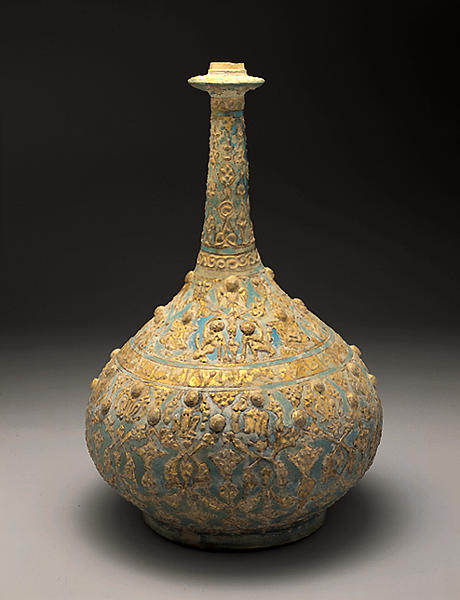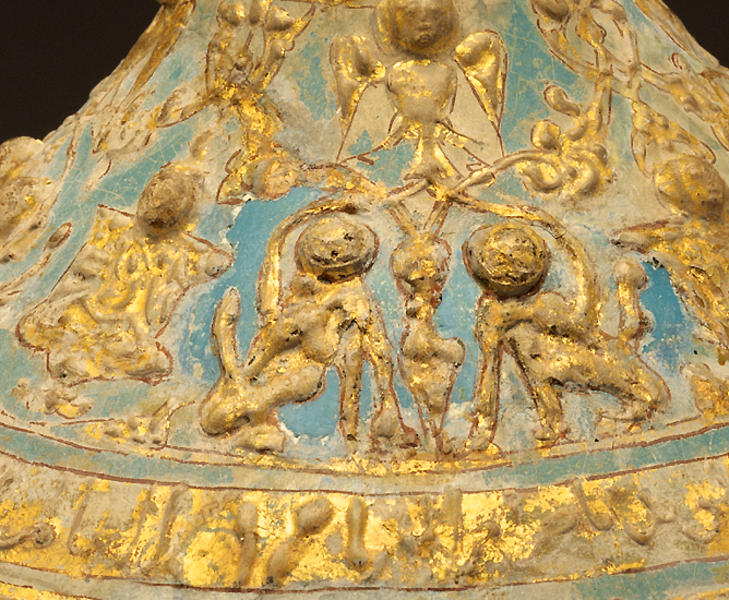Bottle with Long Neck
- Iran
- 12th century
- 12c
- Friware, molded, polychromy, gold overglaze paint
- H-29.8 D-21
Catalogue Entry
This is an exceptionally magnificent example of a Persian ceramic with decorative motifs molded and brought out in relief and glazed in turquoise blue, with the raised areas gilded. Overglaze painted wares are known by the Persian term mina'I, meaning "enameled." Indigo blue and bluish green are used in the underglaze painting; in overglaze painting so many colors are used--red, brown, gray, black, white, gold, and others--that it is sometimes called haft rangi--literally meaning "seven colors," but implying the full spectrum of the rainbow.
Decoration in overglaze painting can be divided roughly into a number of styles. In some, floral motifs and/or arabesques (eslimi) predominate; others have figures like those in miniature paintings. Then there are those like this example, in which molding is used extensively to highlight birds, animals, and arabesques, and the lack of color is compensated for by the elaborate use of gold. There can be no doubt that its brilliance must have been overwhelming just after it was made. Among long-necked vases, there is probably no other using this ornate decorative technique to such an extent.
In the Seljuq period (A.D. 1038-1194), Persian ceramics took an enormous leap forward with the introduction of a new type of clay, called frit, incorporating powdered quartz with white slip and tin glaze. The use of this material, which has a high melting point, resulted in special characteristics; for example, a vessel's walls could be thinner, which made it possible to achieve a transparency that brought Persian ceramics one step closer to the white porcelains of China. Since frit is also more malleable, it was easier to mold pieces, and to design ceramics that were delicate and fine. Glaze was easier to apply on this clay, so that color glazes could be used more effectively. This piece displays these special features to the fullest.
Decoration throughout the body and below the base of the neck includes enthroned figures, fierce winged griffins, sphinxes, harpies (anq'as) with human faces and the bodies of birds with outstretched wings, and crouching lions. The entire area near the foot of the bottle is filled almost exclusively with palmettes. At the base of the neck, the pattern is reminiscent of the long jeweled pendant seen draped down the front of Buddha statues. And as though to separate each section of horizontal patterns, bands of joined swirls form circles below the lip and at the base of the neck. The principal decorative element in this type of vessel, a raised or relief design, is outlined in red. The lavish use of gold foil on the raised areas was probably intended to give the impression of solid gold. Such elements as the heads of animals jutting out in half relief (a style dating back to Marlik gold items of the first millennium B.C.) and the embossing of a half-sphere decoration with cutouts like those found in pierced metalwork, were clearly modeled after brass articles and candlesticks inlaid with silver. A long narrow neck is often found on bottles used for sprinkling rosewater; the unciform flaring out below the tip is a special shape often found on ewers.
An offering inscription in Naskhi in relief on the upper part of the body reveals that this piece was made for governor Tughan-shah ibn al-mu'ayyad of Nishapur in northeastern Iran during the Kwarazm-shah dynasty (1077-1231).1 It is not unusual to find references to dates and makers in inscriptions on metalware, but it is exceptionally rare to find such data on ceramics. Pieces having similar decorative techniques and motifs include a pedestaled bowl with handle in the Khalili collection (London),2 a ewer in the Iran Archaeological Museum (Tehran),3 a ewer with animal-shaped handle in the David Collection (Copenhagen),4 and a bowl with animal-shaped handle in the Tokyo National Museum.
TS
1. Metropolitan Museum 1996, p. 161.
2. Grube l994, pl. 159.
3. Bagherzade et al. l978, color pl. 76 (no. 3984).
4. von Folsach 1990.
Catalogue Entry
Bottle with Long Neck
Iran, about 1173-86
H. 29.8cm
Miho Museum, Shiga
This bottle has a long neck and rounded torso, with a band of circular protrusions around the mouth rim area. The entire bottle has been coated in blue glaze, and the immediate interior edge of the neck and the middle of the foot have also been coated in blue glaze. Three-dimensional designs are covered by gold foil which was then outlined in red. The designs are a repetition of characters, with differences seen in each character form thought to indicate that the characters were shaped after they were attached to the clay. Designs include round leaves above the round protrusions on the neck, with lozenge-shaped decorations on the back surface, and spiraling lines arranged on the top and bottom of the long neck. Arabesques were drawn between these spiraling forms. The torso is decorated with, from the top, human-faced birds, sphinxes with wings facing each other and thrones, and a band of lettering covered with gold foil. Beneath this lettering band, sphinxes facing out towards the viewer are surrounded by arabesque designs. The central band of lettering is a dedicatory inscription which states "Ordered by the Lord, the Learned, the Just, the Mighty, the Strength of State and Religion, the Guardian (?) of Islam and the Muslims, the Sovereign of the World, the King of the East, Abu Bakr Tughanshah ibun al-Mu'ayyad, the Victorious (?)." This inscription was deciphered by Stefano Carboni of the Metropolitan Museum of Art, New York, who noted that inscription details require further confirmation. (See Ancient Art from the Shumei Family Collection, The Metropolitan Museum of Art, New York, 1996, p. 160, note 2.)

